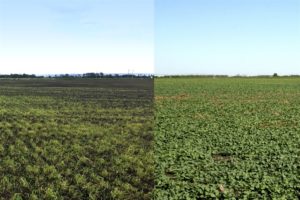 Glyphosate
Glyphosate
Glyphosate is one of the most widely used and effective herbicides (to kill weeds) used in the world today.
How does glyphosate work?
Glyphosate binds to an enzyme, EPSP synthase, preventing it from building essential amino acids that a plant requires to grow. With this enzyme disabled, plants die. EPSP synthase is found only in plants and certain microbes. Humans and animals do not have it in their bodies. We get the essential amino acids we need from our diet.
Without glyphosate, more toxic and less effective herbicides would be used.
How glyphosate changed the way farmers could farm
Perennial weeds (like dandelion and thistle) can pose major problems for farmers because they are so hard. Years ago, tilling them was the only option to control these weeds. When the land was tilled, much of our precious topsoil ended up in ditches and waterways.
With the introduction of conservation tillage, farmers were able to seed directly into standing stubble (last year’s crop remains). Glyphosate allowed farmers to control the weeds because they could spray glyphosate in the early Spring or Fall, while seeding directly into the ground.
See Our PDF to Learn More: DownloadPrint
Journey 2050 Lesson: 5
This resource is a great addition to Lesson 5 – Land-Use
SnapAg:
What are GMOs and are they okay to eat? What does organic farming look like? How are animals like chickens or cattle raised?
snapAG is a series of resources that invite students to explore the hot topics affecting the agriculture industry today. Topics range from organics, biotechnology, GMOs, livestock, and more.
Explore what’s trending in agriculture in Canada by browsing the topics here.
Sources available at: https://aitc-canada.ca/en-ca/learn-about-agriculture
snapAg is brought to you by Agriculture in the Classroom Canada and partners.



